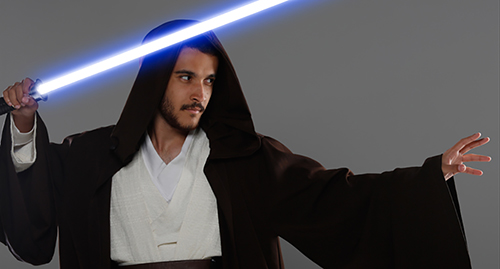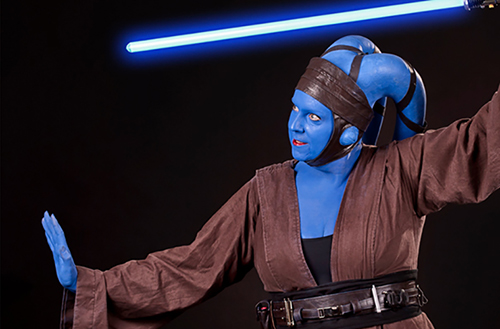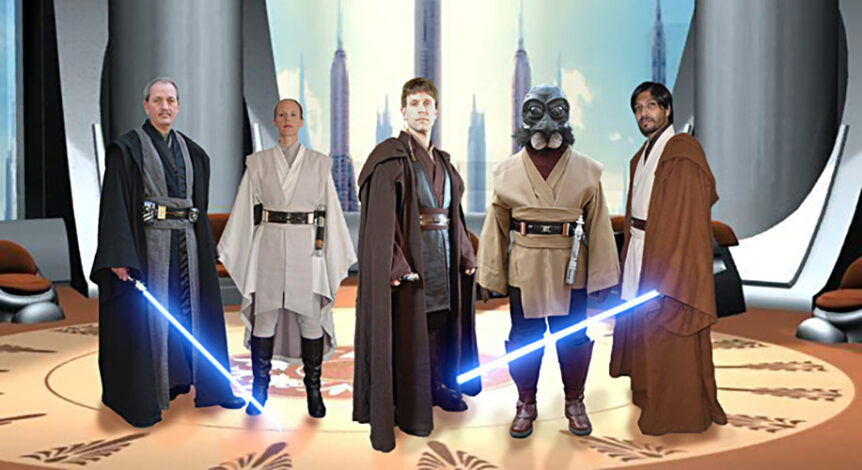CHARACTER DESCRIPTION
A Jedi was a member of the Jedi Order, who studied, served and used the mystical energies of the Force; usually, the light side of the Force. The weapon of the Jedi was the lightsaber, a weapon with a blade made of pure energy. The Jedi fought for peace and justice in the Galactic Republic, usually against their mortal enemies, the Sith and Dark Jedi, who studied the dark side of the Force. (Source Wookieepedia)



This is a chart of suggested colours for Jedi. It is a reference, and not an all inclusive listing.
REQUIRED:
1. Outer tunic (OT):
a. Sleeved. Sleeves should hang at least to the knuckles when the arms are held down at the side.
b. No Kimonos’s, karate/judo gi or gi like construction allowed.
c. OTs may be sleeveless as long as an Inner Tunic (IT) is worn and is long sleeved. No bare-armed Generic Jedi.
d. Sleeveless outer tunics may be fastened at the front and have an attached hood (recommended), though a hood is not compulsory. No vests, or sleeveless V-neck type sweaters may be worn as a sleeveless OT. A sleeveless OT should be surcoat or standard OT style in length. (Ki Adi Mundi and Sarrissa Jeng are examples of surcoat style OT’s.)
e. Tabards should not be worn with Ki Adi Mundi style OT or surcoat. Tabards are required with the standard OT style.
f. OT’s should have a collar approximately 2 inches (5cm) wide.
g. OTs overall length may be variable and may extend to the floor. OT’s minimal length should be long enough to at least cover the wearer’s buttocks and crotch area completely. Mid thigh is preferred. OTs are generally made in a fashion where there is a full skirt (attached to the main body of the OT) where the seam is hidden by the obi.
h. OT´s minimum length must cover crotch and buttocks.
2. Tabards:
Must extend at least to or past the bottom hem of the OT on the front. The back tabards may end under the obi or may extend to (or past) the bottom hem of the OT (or may be the same length as the front tabards). This guideline is obviously for the more traditional length OTs. For OTs that are longer (past the knee or to the floor or where a full length skirt is worn), the tabard length would be more variable.
a. Tabard construction should be such that the front tabards do not overlap. This is often accomplished by constructing the tabards in a “Y” formation where any seam joining the tabard below the obi to the tabard above the obi is covered by the obi. Tabards may cross in the back. Tabards may be sewn together in the back.
b. Scarf-style tabards, having an around-the-neck design, are permitted.
c. A single front tabard, centrally located (covering the crotch area) is permitted.
d. The end of the front tabard(s) may have a variable design (square, rounded, triangular, octagonal, etc.)
e. Tabards may have borders and/or varying decorative symbols or other decorations (such as Aurebesh, etc.). The decorations/designs should not obviously be from an Earth-bound period or culture (Renaissance, Celtic, Asian, tribal, etc.)
f. Leather or pleather tabards are permitted.
g. Tabard width should generally be from the seam at the collar of the OT to the edge of the shoulder and be a similar width as the obi. A general width to use would be 5 inches to 6 inches wide (depending on one’s height and build). Common sense should be used in selecting Tabard width, and the width should be proportional to the costumer’s body.
h. Kataginu are not permitted.
3. Obi (Sash):
The obi wraps around the waist, and should be approximately three times the width of the belt and/or of a similar width as the tabards.
a. Obi closures (Velcro, snaps, etc.) should not be visible.
b. Leather or pleather Obi are permitted.
c. Obi may have borders.
4. Jedi Belt:
Black or Brown Utility Belt (all belts should be proportional to wearer):
* Style A: Similar to Prequel Jedi belts: Wide leather main (inner, against the Obi) belt with a thinner secondary belt (outer) on top of the main belt, and a movie-style or similar buckle on the secondary belt.
a. Thinner secondary belt cannot be loose or “sag”.
b. Button studs should be used to help anchor the outer/thinner belt to the inner/wider belt. Generally, 8, eight button studs (screw posts or Chicago Screws, preferred) are used. Sam Browne button studs are permitted. The metal of the studs should match the metal of the buckle.
* Style B: Similar to Original Trilogy (Luke and Old Ben) belts: Singular wide leather belt with a rectangular, octagonal or oval unadorned buckle.
a. Belts are generally two inches to two and a half inches wide, but the width should be in proportion to the wearer. Very tall or large costumers may need a wider belt. Very short people may need a narrower belt.
b. Belt closures (Velcro, snaps, etc.) should not be visible.
c. No Earth-bound buckles or buckles that obviously belong to an Earth-bound period, culture or to other sci-fi/fantasy genres.
d. Belt and boots should match (be of a complimentary color), i.e., black and black or brown and brown. No black/brown combinations.
5. Lightsaber:
(No toy sabers, no Ultimate FX short saber). The lightsaber may be a static prop (hilt-only). Attached blade(s), LED lights, and sound effects, are allowed but not required.
a. Metal hilt lightsabers are preferred, though custom lightsabers constructed of other materials are permitted.
b. Blade colors accepted are: blue, green, yellow, orange, white and violet. No red, pink or black blades.
c. Double-blade sabers are allowed.
6. Lightsaber Clip:
Covertec or similar style lightsaber clip OR a hook/clip for lightsaber on belt.
a. For the “hook/clip” type of lightsaber attachment, the lightsaber (itself) will likely have a D-ring (similar to the connection system for the armored Darth Vader and Old Ben lightsabers).
7. Pants or skirt:
a. Pants should largely be non-descript without decoration. Traditional pants pockets are permitted, but must not be visible (e.g., hidden under the skirt of the OT).
b. No Cargo pants.
c. No hakamas.
d. Skirts (those separate from the OT) should be long enough so that no bare skin is visible, and may be floor length.
e. No Corellian Blood Stripes (Han Solo Pants).
8. Boots:
Brown or Black Boots – Leather or leather-like (no rubber boots).
a. Mid-calf, but not above the knee. (motorcycle boots, or “engineer” boots, ~ 14″) Extentions like seen in the movie are allowed).
b. No visible laces or outside zippers. When necessary, inside zippers are permitted.
c. Straps & shin-spats are allowed but not required (though can be used to cover laces and zippers).
d. Boots and belts should match (be of a complimentary color), i.e., black and black or brown and brown. No black/brown combinations.
e. Buckles are permitted, but should complement the boot and not detract from the overall look of the Jedi costume.
f. Low-heeled 1 – 1 1/2 inches maximum. Spike heels are not permitted.
g. Mini-Chaps (not above the knee) are allowed.
9. No visible t-shirts.
10. Permitted Colors for Outer Tunics, Inner Tunics, Tabards, Obi, Pants and Robes/Cloaks(capes):
Earth tone colors, preferably shades of brown, gray, black and white. Other earth tones are allowed (greens, blues, yellows, violets and reds (where the reds are darker and in the burgundy family), but should be muted. No bright or loud (sharp) colors are allowed (examples would include: red, pink, neon green, etc.). Combinations of red and black are not allowed, as they are considered Sith colors. Colors of the Generic Jedi costume may be mixed and matched (except for the belt and boots). Legion Costume Judges are the final authority on color. If in doubt, contact a Legion Costume Judge for an opinion on proposed color combinations before construction.
MINIMUM REQUIRED EXTRAS:
You must have at least three items from the following list for formal status:
1. Inner Tunic (IT):
May be a full tunic or a false tunic (meaning a collar, neck portion and sleeves may be added to a shirt or t-shirt). Dickies or tunics/shirts with a Mandarin collar are allowed.
a. If the OT is sleeveless, then an IT must be worn and must have long sleeves.
b. Blouses and standard store bought turtlenecks may be used, but will not be considered ITs for the purposes of costume requirements.
2. Jedi Pouches:
Two (or more) utility pouches or resin cast utility boxes. ( Leather or leather-like material or resin cast boxes, as seen in the Star Wars universe. )
a. The paint scheme on resin cast boxes should blend well with the overall costume.
b. Bags are not pouches, and are not permitted to serve as a pouch/box option.
3. Food pellets (at least one set of four):
Food pellets should be painted a metallic color and may be gold, silver, bronze, copper or pewter. Other metallic colors are not permitted.
4. Jedi Robe or Cloak (Cape):
Large Jedi robe or cloak (cape) with attached over-sized hood, similar to Prequel movie canon robes/cloaks, in the same color scheme as listed for the main costume (see #10. above).
a. A hooded cape with side splits similar in construction that worn by Anakin in Attack of the Clones, is permitted.
b. The hood should be large enough so that (1) when the hood is up, the sides of the hood drape to extend to or cover the shoulders and (2) when down, the tip of the hood should fall near the small of the back (or lower).
c. The sleeves should be full and flare larger on the hand end. When the hand end of the robe sleeve is closed, the length of the end of the sleeve should be at least half the length of the costumers arm (or longer). The circumference of the robe sleeve opening (at the hand) should be at least as long as the sleeve (from shoulder to the hem).
d. The overall body of the robe or cloak/cape should be full.
e. The length of the robe or cloak/cape should be hemmed no shorter than two inches off the floor.
f. A generic Jedi may not wear a robe/cloak that is unique to a face character. Example: Count Dooku’s cloak with neck chain.
ADDITIONAL NOTES:
a. Accessories may include: eye-wear, face coverings and jewelry. Though not required, applicants are encouraged to provide precedence (of their accessory of choice) within the star wars universe.
b. Arm wraps are permitted provided they are of a style similar to or seen in the Star Wars universe.
NOTE: While this latest version of the Generic Jedi Costume Standards are attempting to clarify many questions and issues that have crept up since the last update, please be aware that the costume standards are a guide, and are not meant to be an all inclusive outline of required elements. Finally, some measurements or measurement guides have been given in this latest GJCS update. Costumes must be proportional to the wearer; therefore, some costumers may have measurements that fall outside what has been stated. The judges will be looking for quality of workmanship, accurate execution and use of materials in addition to these general standards check lists. If you have a question about fabrics, colors, and parts choices for your build please contact the LCJs for your category about parts/materials you are considering before you start your build. (LCJ listing here)
COSTUME REFERENCES:
Jedi Tutorials
Padawan’s Guide
RebelsHaven
Reviewed by the Costume Standards Committee: March 13, 2013 through June 4, 2013.
Reviewed by the membership of the Knights of the Jedi Order: June 7, 2013 through June 27, 2013.


